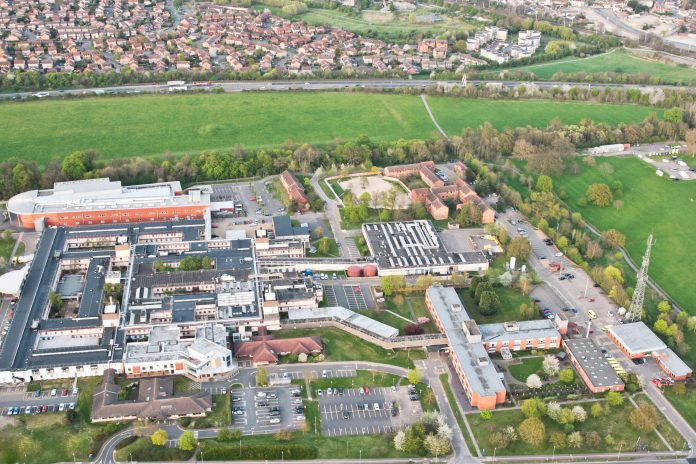Richard Spencer, Construction and Operation & Maintenance Director at E.ON, details decarbonising your hospital estate in the road towards net zero
With the NHS challenged to remove 31 MtCO2e from the NHS carbon footprint, roughly equivalent to the average emissions of 31,000,000 passenger return flights from Paris to New York, some quick wins are required alongside a longer-term strategy.
The NHS hospital estate is made up of 217 NHS trusts with their own ‘Green Plans’ across 1,228 hospitals, so without one clear overarching strategy, it can seem a complicated task. Of course, we understand the unique pressures hospitals face. Still, there are tried and tested solutions proven to improve operational processes, carving out carbon emission reductions and cost-saving efficiencies.
The most important thing for me is to think about the financial savings that can come from carbon reductions, particularly with more energy efficiency and less energy waste. There may be a need for investment upfront, but support can often be found for this, and the savings that come from changes year-on-year can be well worth the time and effort, as well as the impact that positive steps can have on the health and well-being of patients and staff.
Guidance for a net zero hospital estate
I’ve outlined some practical solutions to help guide your hospital estate to net zero.
- Investment:
- With such a disparity in NHS real estate in terms of age, style, and function alongside years of potential underinvestment and poorly insulated buildings, there is a need to consider recycling, reducing wasted energy and even on-site generation. Increasing the efficiency of the fabric of your building with solutions like double-glazed windows and insulation can dramatically reduce your energy costs. Better still, it keeps the heat inside where your patients and staff need it most.
- Fuel costs and emissions:
- It’s not new news that energy costs have increased in recent years, so managing that and reducing emissions can seem difficult. A district heating scheme, which pipes heat and hot water from a central energy centre, will supply an entire hospital estate. It is often a cheaper, lower-carbon method of heating, such as an estate with several densely populated buildings. By connecting buildings with different needs and using data analytics to balance the demands and energy flows between them, energy is effectively distributed and used to decrease pollution and energy consumption in a city.
- Electrification:
- Plays a substantial role in the decarbonisation of the NHS, with electrical upgrades alone being difficult while maintaining business continuity. Providing engineering services to the NHS has been very insightful, as I’ve discovered that where hospitals may appear commercial in their appearance, they are very much industrial in their energy needs for operating daily. Electrification of the NHS will require substantial additional electricity volume to allow the transition from the fossil fuels currently used for power, heating, and cooling. Let’s also not forget hospitals are normally built within city areas which already have DNO capacity challenges. National Grid’s prediction for the UK is that a further 263GW of installed renewable capacity is required to reach its 2050 net zero emissions target, so significant investment is required in the UK’s Infrastructure to meet future energy demands, meaning renewables will continue to play a significant part along with nuclear and green fuels such as hydrogen, to reduce our reliance on fossil fuels. In the short term, switching to an energy provider that supplies 100% renewable electricity is a great way to contribute to a cleaner day-to-day operation.
- Transportation & travel:
- With travel making up 14% of the NHS carbon footprint, it is difficult to influence without adequate infrastructure to support changes in behaviour, there are some easy solutions that you can implement that will help to reduce the number of road miles associated with your NHS trust. Investing in electric vehicle charging infrastructure is an excellent way of encouraging greener travel, but it also offers the potential for a new revenue stream. Electrifying all company vehicles is something we’re doing as a business ourselves and is something the NHS should consider, given the ban on petrol and diesel cars by 2030. Alongside that, encouraging the local community to be more active by walking to work and appointments will only contribute positively to both physical and mental well-being, ultimately impacting patient numbers and supporting decreasing air pollution and emissions.
- Anaesthesia & other medicines:
- Equate to 25% of the NHS carbon footprint, there are key opportunities to reduce the carbon emissions related to prescribing and using medicines and medical products. Coming under the scope 3 emissions, to make these changes, the NHS will need to explore medicine optimisation, reducing waste along with responsible capture or disposal of waste medicines or considering using lower carbon alternative medicines to reduce CO2 emissions associated with anaesthetic gases, inhalers, and other medicines. Although it isn’t something directly in your power to change, being mindful of your supply chain and what suppliers you use, their manufacturing processes and ensuring they’re taking positive steps to reduce their emissions will indirectly impact the carbon footprint relating to your NHS trust.
The above are my chosen top five areas of focus with clear solutions to help the NHS on its journey to net zero, these could include the below too, but there will be many others.
- Waste generated by NHS services – i.e. single-use equipment.
- Supply chain engagement.
- Catering services – i.e. sustainable foods with local sourcing.
NHS: The race to net zero
The NHS is no different to the private sector in the race to net zero; today, there is no silver bullet that can deliver zero carbon across our organisation, so what happens next? First, understand the current carbon footprint and build a strategy/green plan combined with a people and technology plan. Clearly, investment is going to be a key requirement and should form part of the strategy to ensure key stakeholder engagement. Still, it shouldn’t be a barrier to your net zero journey. There are many funding options out there, and we have a great deal of experience applying for and successfully securing significant amounts for our customers.
No one will argue that net zero is a significant challenge, but through collaboration, knowledge sharing and people investment, it’s something that can be achieved. It also needs to be viewed as much more than tackling climate change by reducing carbon emissions. The NHS could make changes in delivering reduced carbon emissions on their estate, including lower energy and operating costs, freeing up more budget for front-line services. Improving the local community’s well-being and physical health from cleaner air and getting patient and employee buy-in around the positive steps your trust is taking to improve the air quality will only increase morale and motivation for the challenge ahead.

This work is licensed under Creative Commons Attribution-NonCommercial-NoDerivatives 4.0 International.











